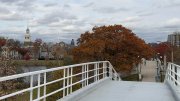Once each semester, stretching into the recesses of recent memory, the Lampoon has deposited a parody of its arch-rival, the Crimson, in every undergraduate doorbox. The often hilarious send-ups of the self-important daily feature specious and sometimes obscene articles, but imitate the look and style of the Crimson and attribute the stories to real-life Crimson writers. (As a Crimed, I had the dubious honor this spring of finding my name above a story about the fictitious merger of the Institute of Politics and the International House of Pancakes, forming a new Institute of Pancakes.) This semester, however, instead of one parody of the Crimson, the drop-off included mock issues of the official University Gazette, the Crimson, the Independent, and the Advocate.
It was a small but telling change--a tacit acknowledgment that the age-old rivalry between the two publications has less salience at a moment when the number of campus publications has proliferated. A revolution in desktop publishing over the last decade, combined with the expanding diversity of the undergraduate student body, has caused a boom in the number of campus media outlets, compelling older publications to reflect more critically on their audience and on their ability to represent the enormous variation in student backgrounds and interests.
The spurt in publications has to a large extent been fueled by the simplification of desktop publishing brought about by computers. Few publications own their own buildings or occupy precious office space in the basements of Harvard dormitories. So the somewhat sterile Room 120 on the ground floor of the Science Center has become a mecca for student publications. With high-capacity disk drives, an image scanner, and powerful Macintosh terminals, the computer laboratory is often filled with entire editorial teams simultaneously editing articles and laying out pages. Other publications with technology-savvy editors do the same in dorm rooms. Among them is Diversity & Distinction, a three-year-old journal dedicated to exploring issues of identity, ranging from deaf culture to the Baha'i religion. The quarterly has featured recent stories on stereotypes facing athletes, the dilemmas of working-class identity at Harvard, and roommates who happen to be gay. Tedious production aspects like typesetting and shooting halftones are relics of the past; Diversity & Distinction submits each issue to its printer on a single 100-megabyte disk, freeing its editors to worry about content.
The fact that students now access information from a plethora of new media has compelled the Crimson to reexamine how it delivers its news. Still ensconced in its headquarters at 14 Plympton Street, the newspaper celebrates its 125th anniversary this January and has undergone a host of changes in the past year. The paper began free distribution to undergraduates in September for the first time in its history, following an experimental year in which it was delivered free to all freshman rooms. The daily press run spurted from 3,000 to 5,000 copies, enough to accommodate all undergraduate doorboxes as well as home and office subscriptions. A redesign of the paper enlarged graphics and headlines throughout, and permitted the publication of daily photos from national wire services for the first time. Last year the Crimson replaced the print version of its irreverent Confidential Guide to Courses at Harvard with an on-line edition, and the paper has enlarged and improved its World Wide Web site, which on some days has more readers than the newsprint version. "I think the Crimson really needed a shot in the arm this year, and it got that," says president Joshua J. Schanker '98.
He acknowledges that many of the changes have been mandated by the evolving ways in which students get news. They can now read about national and foreign events at the click of a mouse, browse through course listings on the Web, and get wind of most campus events through e-mail announcements. Gone are the days when the University posted official announcements in the Crimson.
The changes at the Crimson arrive at a moment when the number of campus publications is ballooning. In the late 1960s, recalls Thomas G. Stemberg '71, M.B.A. '73, the second publisher of the weekly Independent and now chief executive officer of Staples Inc., "There was the Crimson, the Advocate, the Lampoon, and the Independent." The current Unofficial Guide to Life at Harvard, published by Harvard Student Agencies Inc., lists no fewer than 42 campus media organizations, most of them publications. Publications are the second most common type of student group on campus: of the 226 officially recognized student organizations last June, 26 were publications. (There were 47 ethnic-cultural organizations, the largest category.) While the 1980s witnessed the creation of several political publications, such as the Salient and Perspective, many of the newer publications explicitly raise questions of identity. Although Diversity & Distinction eschews a political bent, editor-in-chief Jia-Rui Chong '99 says, "I'm afraid that the magazine is going to be pigeonholed in a lot of ways, as a sort of bastion of liberalism."
Typical of the new breed of campus publications are magazines like Nuestra Voz, a reincarnation of an earlier magazine, Del Sur, published by Raza, an undergraduate Mexican-American and Latino student organization. Its debut issue last spring featured articles, poems, and essays, including a satirical lyric that face- tiously described all the most desirable qualities in a Mexican-American housekeeper. "When you come to Harvard, sometimes your sense of community, your understanding of your respective community, becomes heightened, because you're so far from it," says Alfred Fraijo '99, president of the biannual magazine. "The challenge is to voice yourself as an individual; that perspective is sometimes related to the fact that you have a Latino background."
Unlike more established campus publications, many of the newer periodicals actively attempt to draw students from a broader range of backgrounds. They may not attract students aspiring to win a Pulitzer, but instead those who want to get across viewpoints and perspectives that may not appear elsewhere. Fraijo, for example, hopes to pursue degrees in law and public policy; he said he joined Nuestra Voz because he saw an opportunity "to provide a forum for a different voice on campus."
It is this search for "a different voice" that captures the ambiguity I have often felt in working at the Crimson. As a freshman comper I often trudged wearily home after covering seemingly interminable Cambridge City Council meetings, or running after fire trucks, never finding any real conflagration. I was impressed, however, with the open, democratic structure of the organization--anyone who completes the required number of stories is automatically elected a news editor--and also with the paper's tremendous resources and its celebrated alumni. But I discovered that the newsroom environment could also be quite alienating. Coming from a New York City public high school, I found few other Crimeds who were from minority backgrounds or who held a term-time job. Juggling a substantial extracurricular commitment, classes, and a clerical position at a graduate-school office became increasingly challenging. I decided in my sophomore year to limit my involvement and to try other activities; I came back to the Crimson as an editor in large part to help the paper foster a more inclusive and nurturing atmosphere.
An internal study last year found that only half of all Crimeds and just one-tenth of executives (the upper-echelon editors) had some form of financial aid, compared with three-fourths of the student body as a whole. To address the problem of representing, in its staff and its coverage, the diversity of Harvard students' backgrounds, the Crimson this spring is launching a pilot program, administered by the College's financial-aid office but funded by the paper, which will disburse aid to students on staff who are eligible under the Federal Work Study Program.
The proliferation of new campus publications has caused other established publications to make efforts to bolster readership as well. The Harvard Political Review launched a redesign last year, and is trying to attract more student interest. "One of our problems is finding an audience here," says Ilana Eisenstein '99, the new editor-in-chief of the Political Review, which is funded in part by the Institute of Politics and publishes interviews with many of the political celebrities who speak at Harvard, including, in recent issues, Senator Edward M. Kennedy '54 and House Speaker Newt Gingrich. "There are so many publications on campus, it's really difficult to create a niche for yourself as a magazine that people read and talk about," Eisenstein says. The Harvard International Review contracted with a Washington-based firm to redesign the quarterly, according to editor-in-chief Shirin Sinnar '98; the new look will debut this spring. Sinnar emphasizes that the magazine was reconfigured to look more like a popular publication than an academic journal, even though many of its subscriptions come from libraries and academic institutions.
The blossoming of new campus publications does not mean that they have escaped practical problems, especially financial ones. At $1,700 for a press run of 2,500 copies, Diversity & Distinction must rely heavily on grants from the Undergraduate Council and the Harvard Foundation for Intercultural and Race Relations, as well as local advertisers--who in turn are increasingly besieged by a horde of students desperate for funding. This fall, the magazine printed only 2,000 copies because of financial constraints. "A lot of the advertisers here are solicited so often," says Jia-Rui Chong, "that it's kind of a survival of the fittest."
As older publications seek to shore up readership and membership, some of the newer periodicals may prove, like many predecessors, to have a short life span (see page 88). But in an era of fast, accessible information, the proliferation of media is likely to continue. Walking past a campus publications kiosk, or down any residential hallway, one is struck by the variety of new perspectives. As Harvard continues to attract students from more varied backgrounds, and as the tools of communication expand their reach, the desire to find one's voice and--make it heard--is likely to persist.








